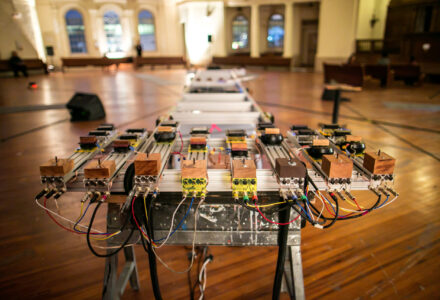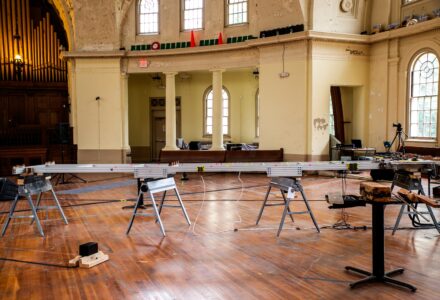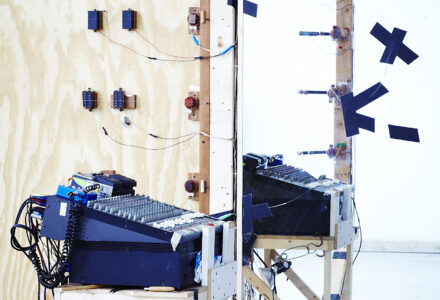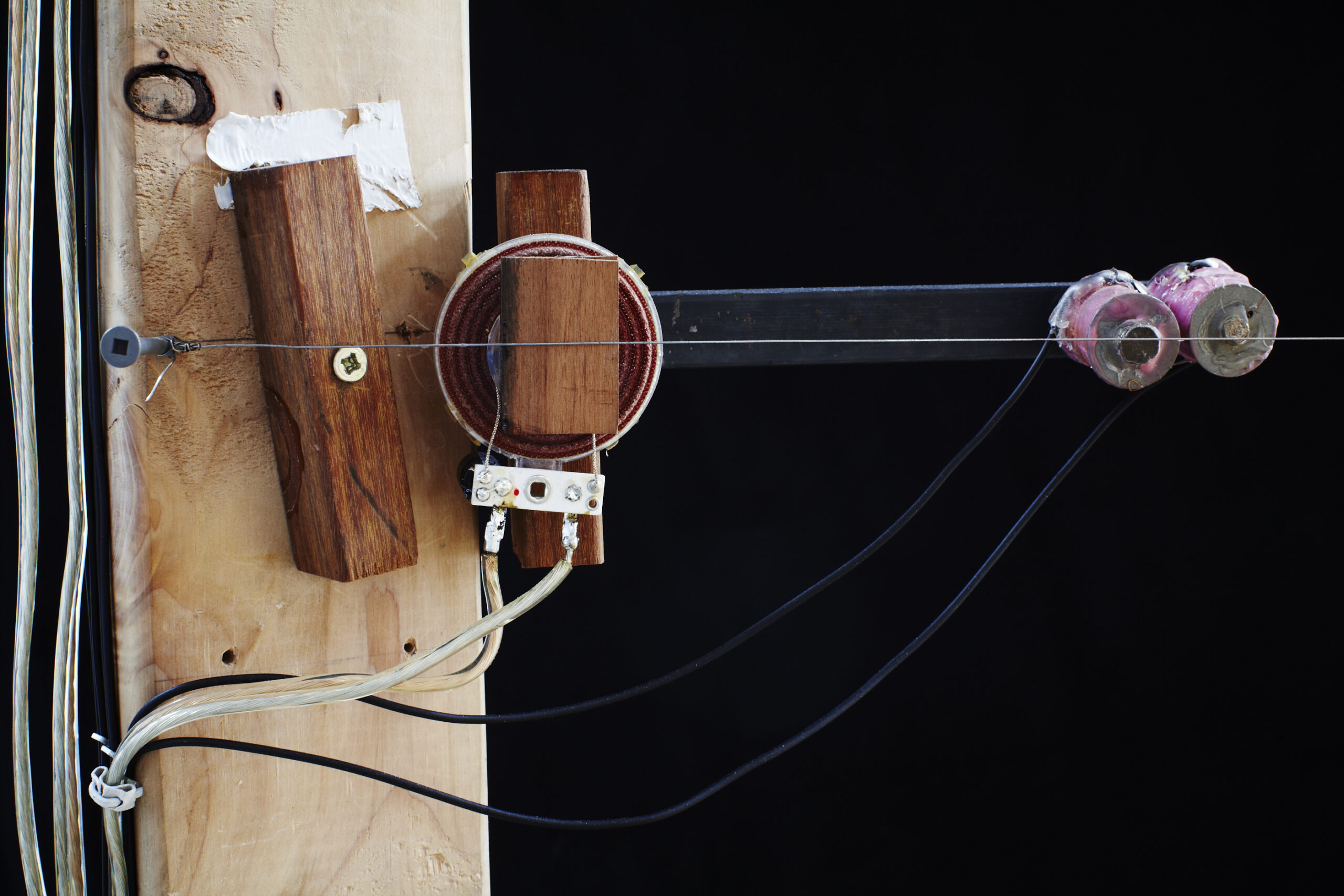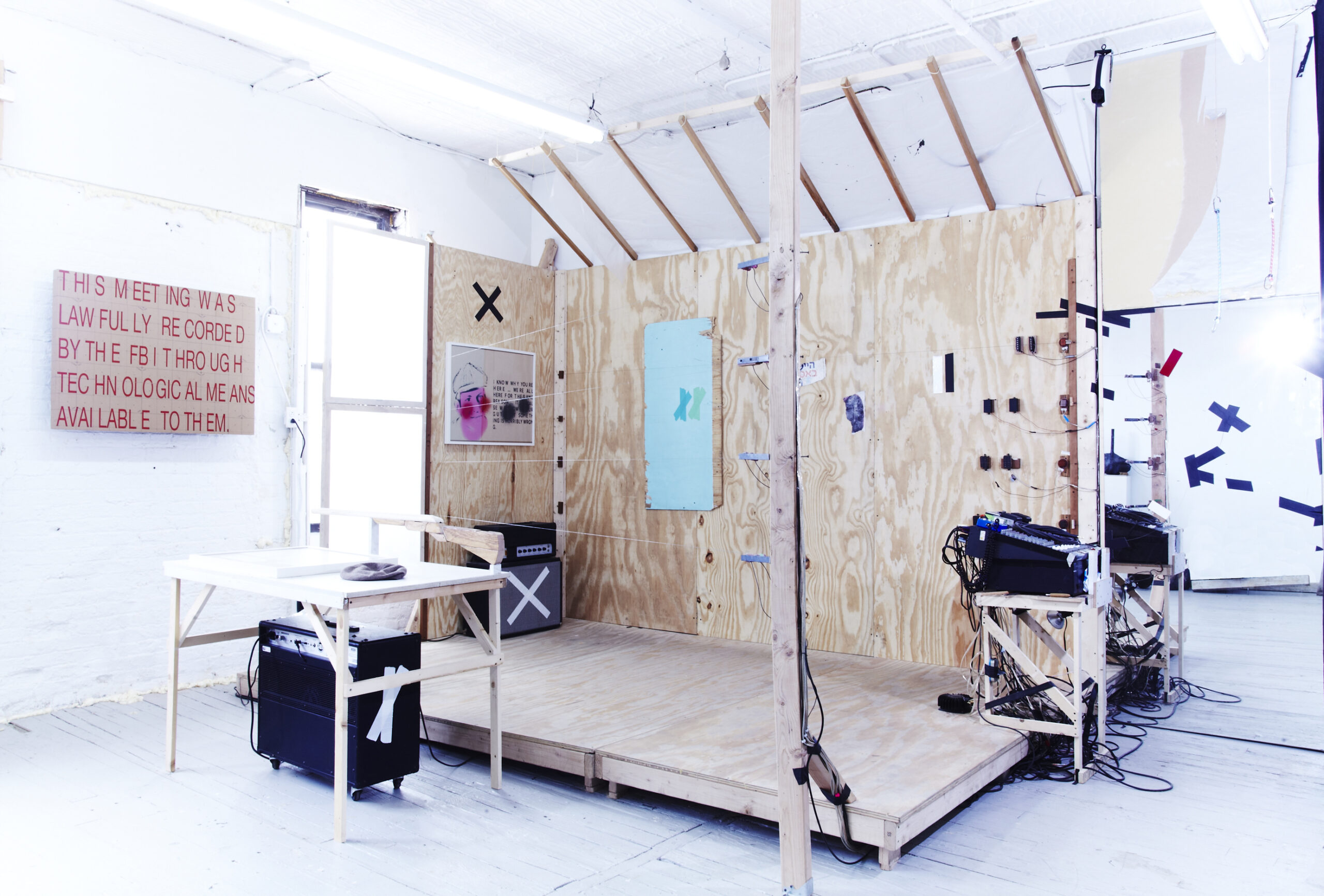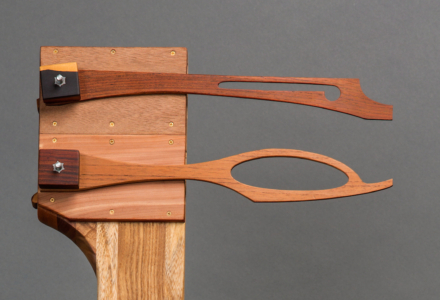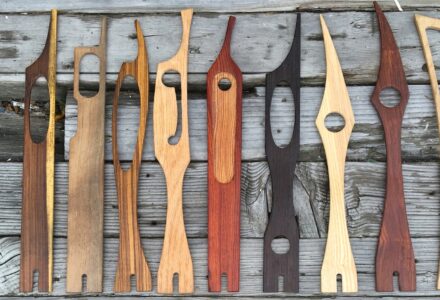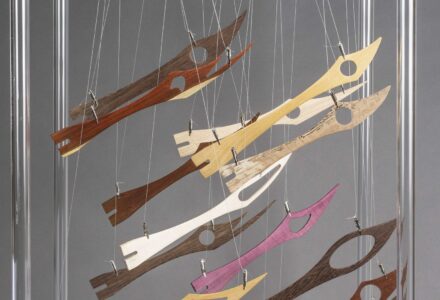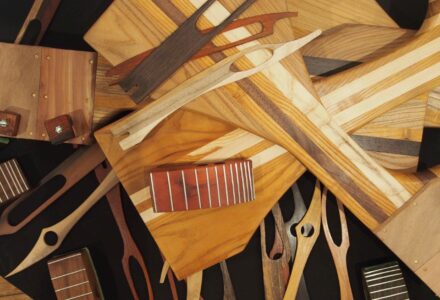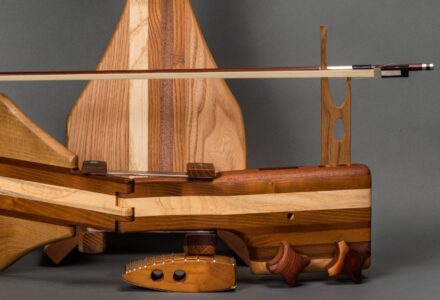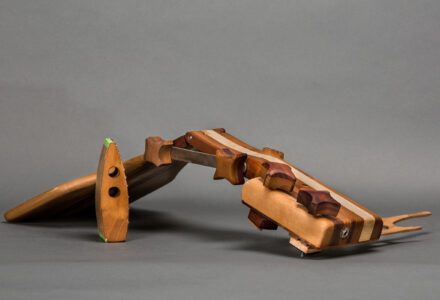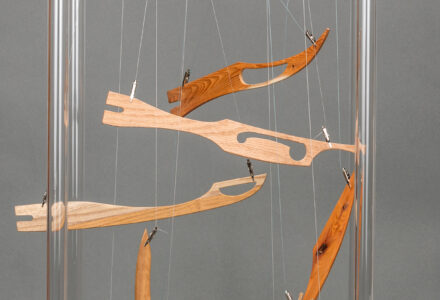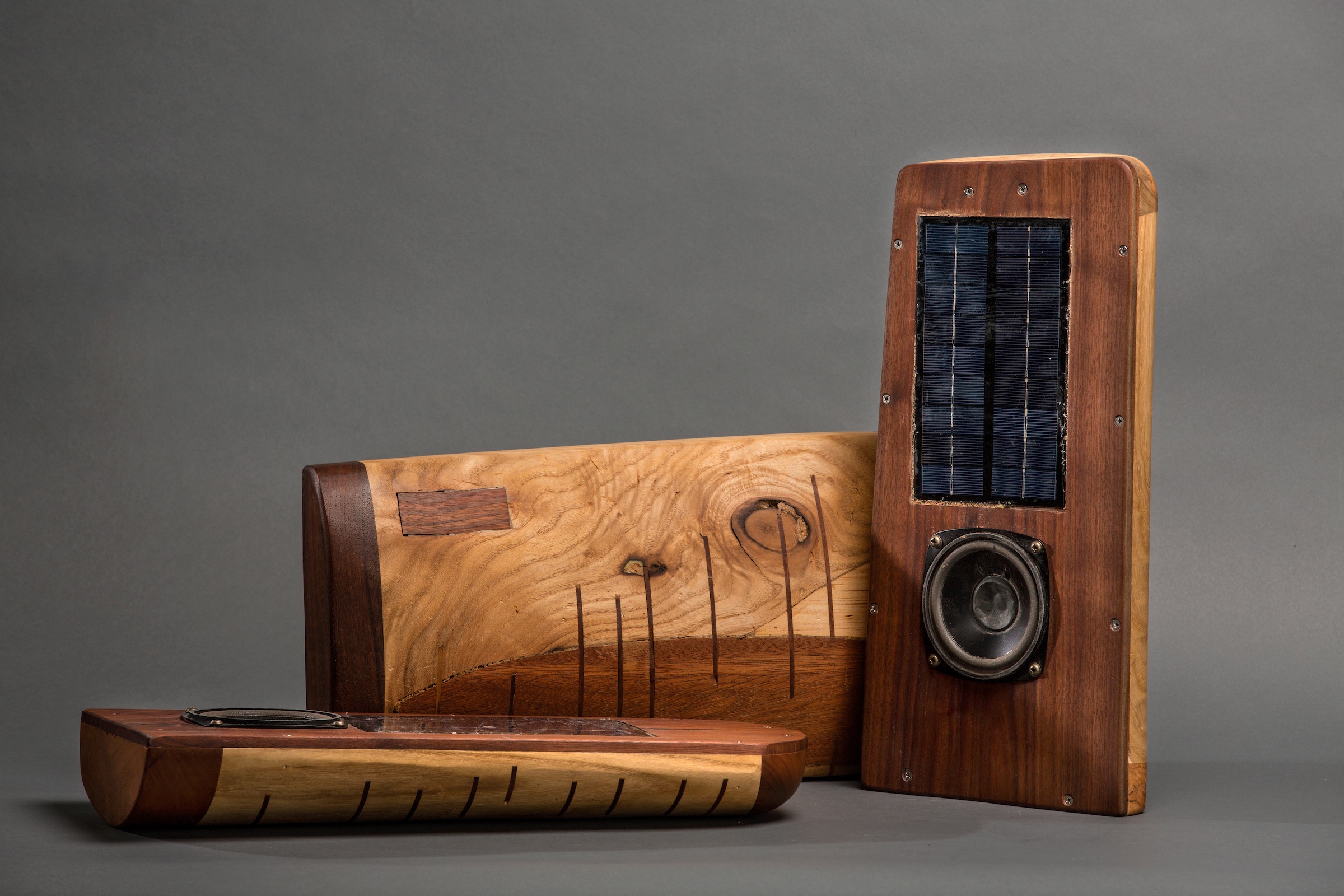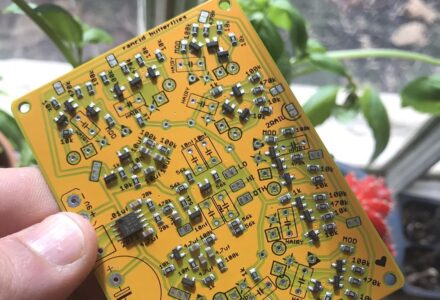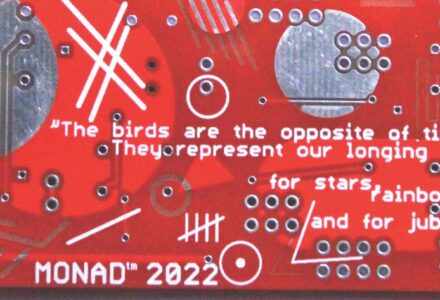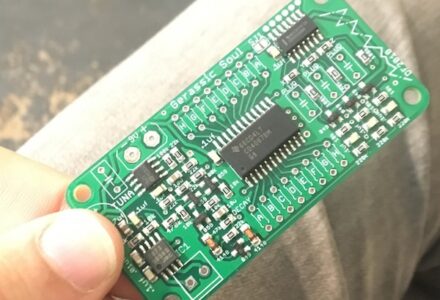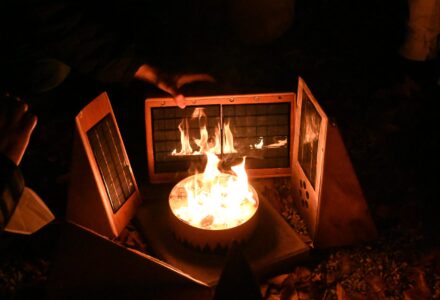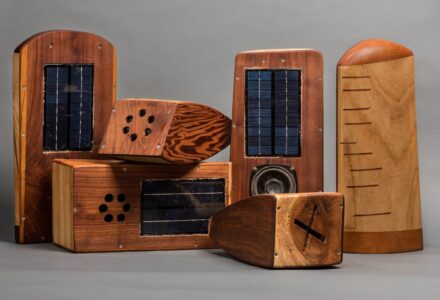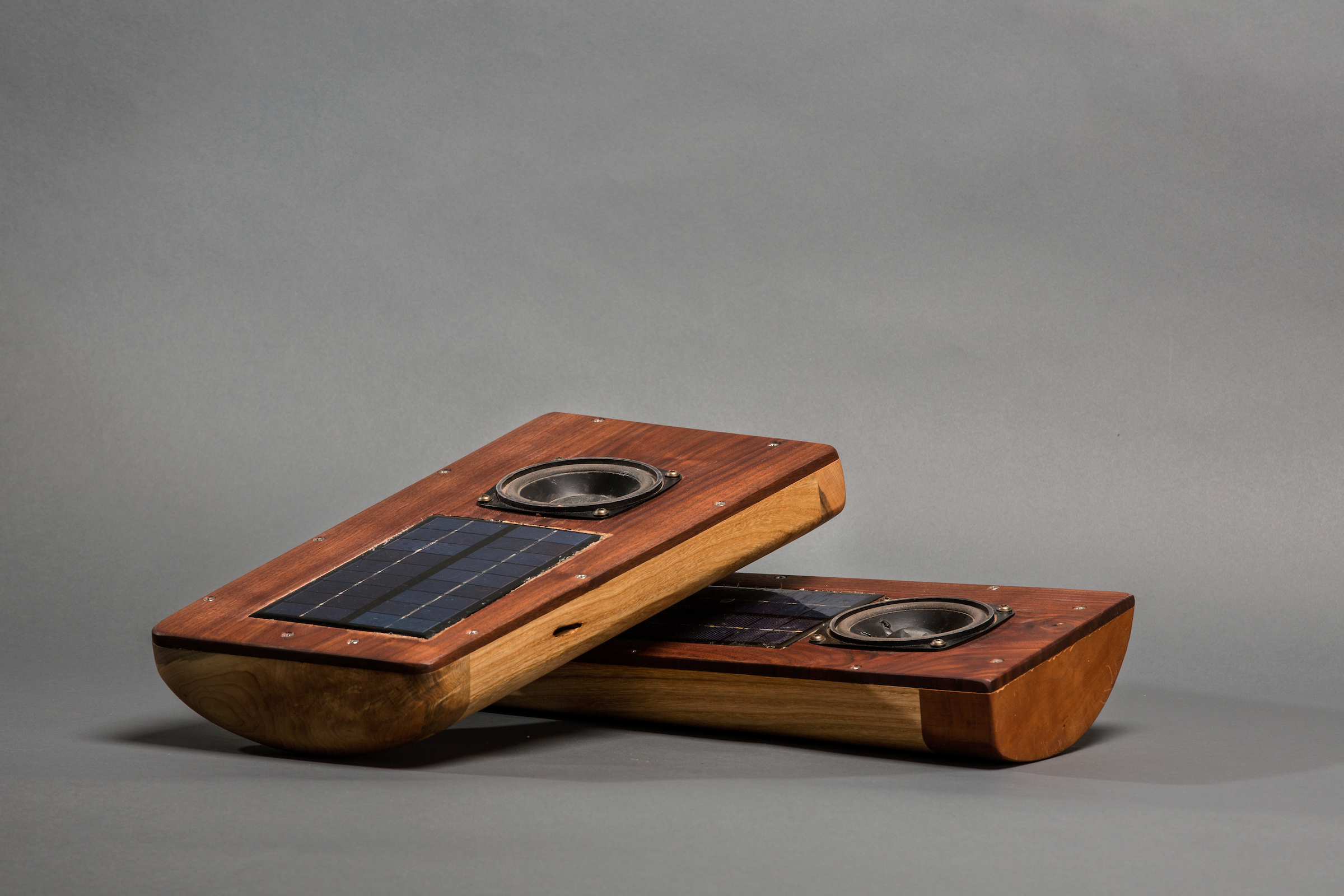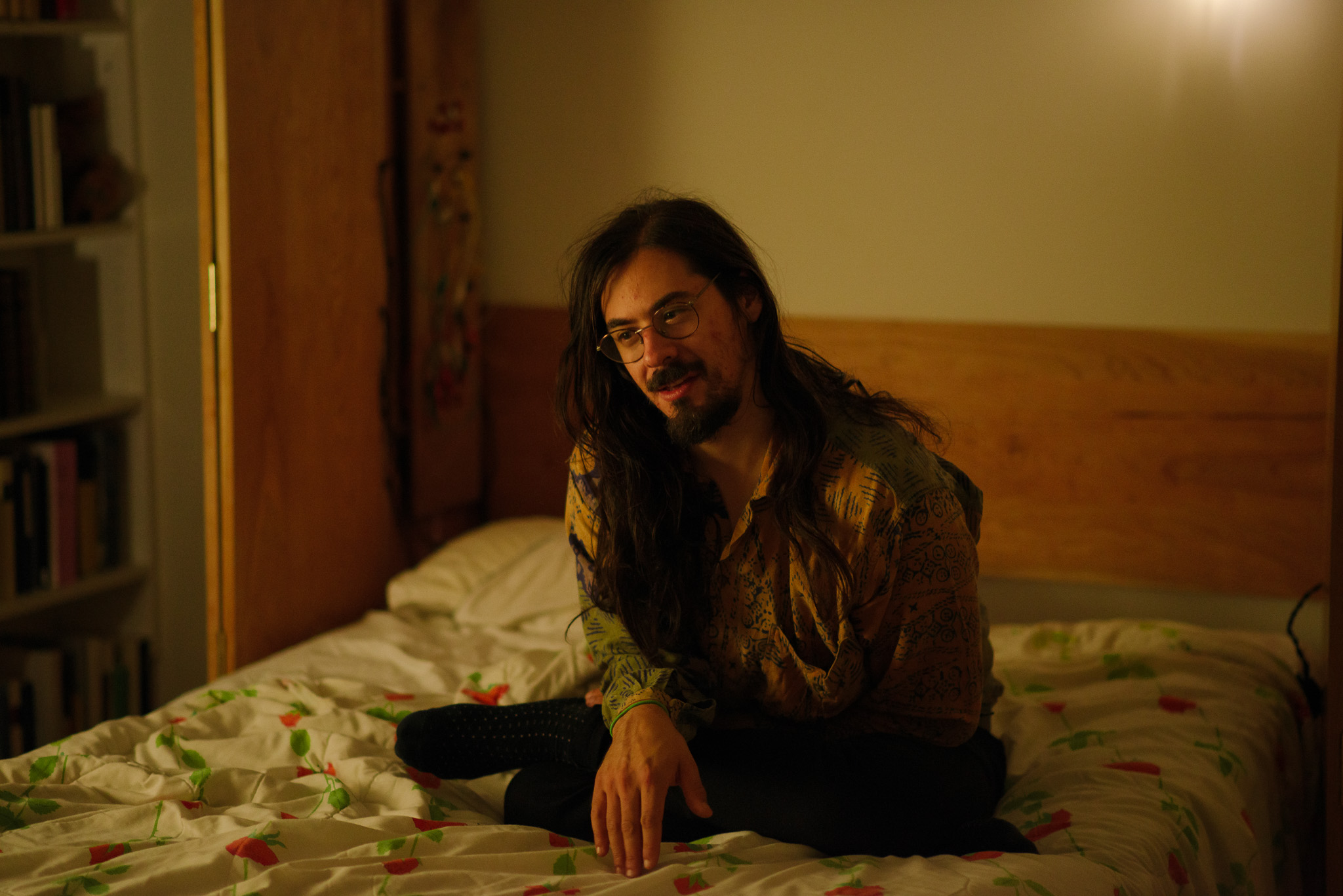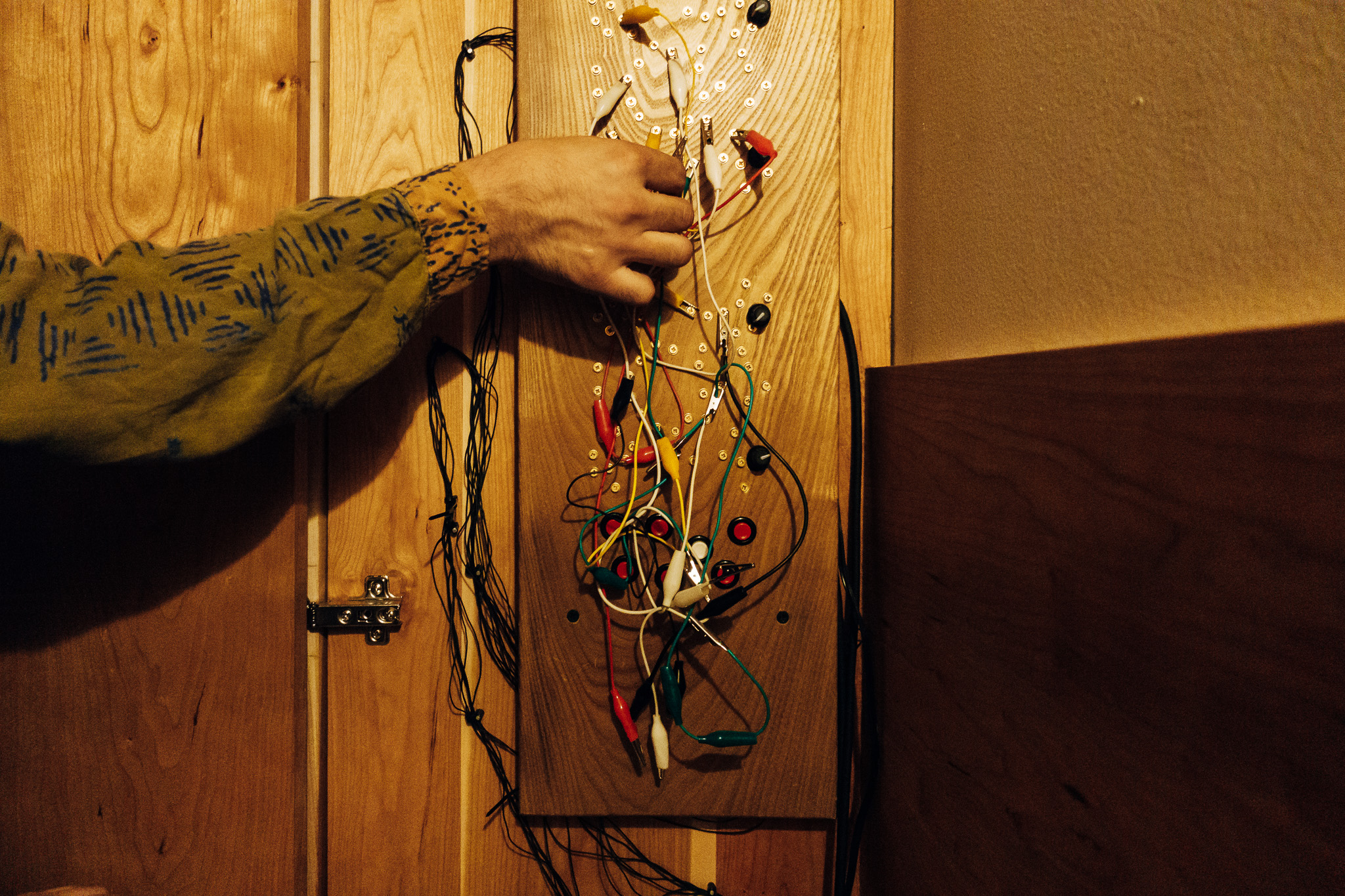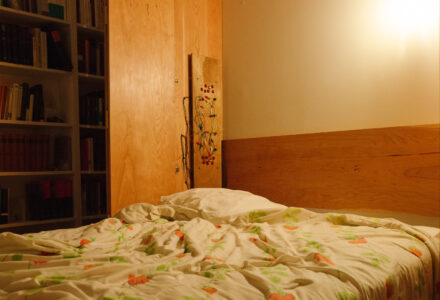this page covers three major areas of my artistic output: the aesthetics of hearing damage, the translation of light to sound, and many experiments with the daxophone. if your time is limited, please limit your viewing to one project from each category. if you’re curious, i’ve also included an appendix that includes interpretive work, and other projects that don’t fit the categories described above.
1) Composing the Tinnitus Suites
Composing the Tinnitus Suites: 2020 (excerpts)
(2020) 3:52
I want to make music that makes tinnitus desirable rather than hated or feared. I do not want to get used to my hearing damage—I want to use it. During a residency in 2011, I created a system of tensioned twenty-foot long piano wires activated by mixer feedback; I could sustain its tone infinitely, using guitar pickups and pressure transducers to coax the strings into vibration. I called it Lady’s Harp, named in tribute to Ellen Fullman, Maryanne Amacher, and the ancient Greek Aeolian harp, whose strings are set into vibration by the wind. I have made five iterations of Lady’s Harp. Once I showed the piece to a neuroscientist, and she remarked that it functioned as a mechanical model of the inner ear. I had stumbled upon the perfect vehicle for Tinnitus Music.
- transducer detail (2014)
- installation (2014)
- freestanding version (2014)
- pickup detail (2014)
- freestanding version (2014)
- installation (2012)
- transducer detail (2012)
- installation (2012)
Composing the Tinnitus Suites: Mise-En Transcription
(2015-2016) 37:00
Composing the Tinnitus Suites is an ongoing series of work which explores the aesthetics of hearing damage. The aforementioned Lady’s Harp is the dark star of this music’s universe—most of my Tinnitus Music orbits around it in some way or form.
This piece is a transcription of an earlier recording from the Tinnitus Suites saga, which I created on the Lady’s Harp in 2011. After being commissioned by ensemble mise-en, I was curious whether I could make work in the Tinnitus Suites project, but without needing to do a site-specific sound installation—using the sounds of the Lady’s Harp without the burden of setting it up.
Using Fourier analysis, I approximated the harmonic content of the Harp’s strings and transcribed it for the six instrumentalists of ensemble mise-en. It occurred to me that this work could have been done more quickly with a computational process, but I did it all by hand, and savored the chance to pore over each measure, and decide what overtones should be allocated to each instrument. Thus the ensemble only plays what I was able to hear.
This piece is always played alongside tape accompaniment in loudspeakers.
Click the image, or this link, for the score!
This piece was premiered as part of Composing the Tinnitus Suites: 2016, a 4-part concert series about the aesthetics of hearing damage, which was supported by a Performance Project Grant by The Pew Center for Arts & Heritage. I was the lead composer and director for this concert series. The following video is an excerpt from the piece’s premiere, at The Rotunda in West Philadelphia.
Composing the Tinnitus Suites: 2016 (excerpt)
(2016) 14:29
featuring Cleek Schrey (Hardanger fiddle) and Ron Shalom (contrabass)
I had never combined the Lady’s Harp with conventional instruments before 2015. I spent my final year in graduate school with Shalom and Schrey, and during this time we developed deep trust and conceptual rigor. This piece was composed through a process of iterative improvisation, keeping the parts that worked and recycling material. I noticed the strings of the Lady’s Harp would come to life much faster, buzzing into feedback mode, buoyed by the shared frequencies of our machines. It was like the boundaries between our instruments were breaking down—Cleek would bow a note on the Hardanger, and a note would sing out on my Harp. Ron’s end-pin scraping the floor would cause deep bass swells. Their own melodic cascades intertwined, crossing ranges, enveloping each other’s registers. While playing, I lost track of where the sounds were coming from. Ron? Cleek? The Harp? Inside me? Perhaps we became each other’s tinnitus.
2) The Daxophone
- the A group
- daxophone parts (2016)
- most of these are scroll sawn.
My entry into experimental music started with the daxophone. The daxophone, created by Hans Reichel, is a more elegant construction of the instrument every child discovers when they put their ruler off the edge of their desk and pluck it: BOING! When that ruler is played with a cello bow, it produces a much different sound: a very vocal, vowel-ed tone that could easily be mistaken for another instrument or animal. One cannot buy a badger-cello, so I learned to build my own. I noticed that every piece of wood sounded unique, and I could control the instrument by altering its shape.
In the Daxophone Workshop
(2019) 3:04
Since 2005, I’ve always built daxophones in my itinerant workshop, meaning, wherever I happen to be, with a slew of hand tools and whatever else is in front of me. This process has changed a lot over the years, so this is what it looks like today.
The Daxophone Consort
(2019) 2:00
The Daxophone Consort (or simply, The Consort) is Daniel Fishkin (me!), Cleek Schrey, and Ron Shalom. After a decade of solo experimentation on the daxophone, I began to build daxophones for others, testing my design skills by sharing instruments with my collaborators. This band formed organically, and a shared ensemble sound blossomed. Since 2015, we are the world’s only extant daxophone consort—an ensemble made entirely of members who play the same instrument. Ron Shalom and Cleek Schrey each bring a personal history of string techniques to the daxophone, including the conservatory and old time music. We develop realizations of historical experimental music and baroque motets, commission new daxophone pieces from living composers, and generate new pieces based on shared improvisational grammar.
Masking Songs (excerpt)
(2020) 12:00
I was curious to continue composing with concepts I found in my research on hearing damage. I wanted to find some way of extrapolating these ideas without using the Lady’s Harp, and notating them for my daxophone.
Masking Songs deals with the principle of auditory masking, in which the perception of a sound is affected by another sound. In lieu of a medical cure for tinnitus, auditory masking/suppression is one of the primary means for attenuating the perception of phantom sound. This is explained by the “critical band” principle, a psychoacoustical concept which describes ranges where sounds can interfere with each other. However, in people with hearing damage, critical bands are shifted or completely absent. This phenomenon is emphasized with tinnitus, which after much experimentation, has been proven to not respond to the critical band principle, unlike all sound in the acoustic world. In Masking Songs, I applied these principles of neuroscience to a variety of notation techniques and improvisatory strategies. The effect is a constantly shifting state of foreground and background, in which instruments in the world of the piece veer from signal to noise constantly.
This piece was composed for two ensembles playing together: Science Ficta, an group of viola da gamba virtuosi, and my own Daxophone Consort. The reedy sound of gut strings blends well with the mammalian cooing of the daxophone. Both instruments are capable of mimicry, harsh noise, and luscious resonance.
Click here, or on the picture below, for the score!
3) Diegetics / Light to Sound
Players
(2021) 04:10
A Solar Sounder is a synthesizer played by sunlight—no batteries, and no knobs; instead, its speaker output is governed by sunlight, powering an internal synthesizer designed to work with ever-fluctuating power source. By itself, a Solar Sounder by itself is a crude machine, but in a group, they come to life, twittering away merrily, their songs changing as the day passes. I join a larger history of artists doing creative things with solar power ever since this technology became publicly available.
The sculpture of Solar Sounders happens on a micro and macro level. First, it involves the construction of hollow, resonant boxes, and the configuration of them in light and shadow to produce their desired sonics. But even before the boxes are built, transistors must be arranged on circuit boards to produce unique instrumental voices, and their voices must be tuned to different ranges to blend into the large ensemble.
I also share these circuits with the public in the form of easy to assemble circuit kits, via my sister company, Monad.
WHAT YOU SEE IS WHAT YOU HEAR: TIMES SQUARE (excerpt)
(2010) 10:52
I went to Times Square with some homemade light microphones, and listened to the light waves. Many electronic lights are actually flickering off and on faster than the eye can see. In the place of a normal microphone, the photodiode lets us hear this flickering as pitch. What you see is what you hear, with no special effects or processing added. I don’t usually like being in a place like this, but the sound camera has a transformative power, like the skateboard, which turns the parking lot from urban wasteland to paradise.
“you can’t do anything you want + butterfly in the sky (semya REMIX by kuhn)”
(2017) 4:24
oscilloscopes, photodiodes, voice, tape
One day at my workbench, I realized that the green CRT bream of of my oscilloscope is a very stable sawtooth waveform. I used my photodiode pickups to sonify this signal, and then built an entire synthesizer system out of four oscilloscopes and a mixer. By sending the same signal into both mixer & oscilloscope, a feedback path is made entirely in the domain of light, between the screen of the CRT and the photodiode microphone. The oscilloscope shows its own sound, and as I manipulate it, I learn from its visual language in order to predict its music. I send my voice into the oscilloscope beam, which translates it into light and then back into sound once more. I call this project, Dead Lion.
appendix: transcriptions & older work
Pendulum Music (Steve Reich)
(2014) 10:54
Steve Reich’s Pendulum Music is a classic feedback piece from the early days of minimalism and process music. Old pieces of the avant-garde can seem dusty, but feedback, which is unique in each instantiation and each resonant cavity in which it is found, should never actually get old. I wanted to add another wrinkle in the story of this piece, and so shifted the medium from sound to light. Instead of speakers, I use oscilloscopes, and instead of a microphone, I use homemade light microphones made from photodiodes. Besides this, the basic structure of the piece is unchanged.
Ryoanji (John Cage)
(2014) 2:58
I want to filter canonical pieces through my own lexicon. Ryoanji (1983) is based on the famous stone garden in Kyoto, Japan that contains fifteen stones of different sizes laid out on a bed of raked sand. John Cage wrote the piece for percussion obbligato, or an ensemble of twenty, and any number of soloists: oboe, voice, flute, contrabass, and/or trombone. The dry, repetitive percussion represents the raked sand. The solo parts are graphical scores derived from Cage’s tracing of various stones, so that all the solo parts exclusively produce glissandi. Cage never wrote any music for daxophone, but I thought that daxophone might capture the microtonal essence of the piece. The daxophone is resolute in its refusal to intonate precisely. Thus, the attempt to produce a linear glissando with the dax produces a notched gurgle, a broken curve that might resemble the outlines of the rocks in the score.
Bed Piece: Pelta Feldman Variation
(2015)
In 2011, I dreamed of making a circuit that would sonify the discovered plurality of a sexual encounter. The frame for this artwork was thus the bedframe itself, where many of my intimate experiences have occurred. I wanted to make a passive piece, one that would make music when I was with someone, but not require the gestures of an instrument. I didn’t want to put music in the background, but rather allow it to be absorbed by the larger, more glacial pace of our every- day movements over many months. But I wasn’t in a relationship at the time—it occurred to me that most of my nights were not spent having wild casual sex, but being by myself. I wanted to make a piece that would sound when with a partner, and would be silent when I was alone.
I finished the circuits for this piece in 2014, but never made a public presentation of the work, which seemed too private to share. In 2015, I was commissioned by Room & Board to create a permanent installation of my Bed Piece. The original piece that I imagined—a one-year performance in which the bed synthesizer is turned on every night—remains un-performed. In keeping with the privacy of this piece, no sound or video is documented, only pictures and the suggestion of an idea.
- DF on Bed Piece
- Synthesizer Detail
- Wide Shot
http://roomandboard.nyc/salons/bed-piece/ External documentation
Program from the opening of Bed Piece
Candle Piece
(2010) 4:13
I was inspired by Nic Collins’ circuit sculpture In Memoriam, but thought that he picked the wrong candle. I designed my own circuit which is tuned to react to the flame of a candle. In darkness, it is silent. When the candle is lit, the circuit plays music which changes as the candle burns. I used “five-minute candles”, which burn quickly and provide for a dynamic performance.
Of(f) Course
(2012) 4:49
daxophone, voice, and electronics (with Zach Dunham, percussion)
This is an older composition that showcases early work with my now defunct punk band, Dandelion Fiction. Songwriting isn’t part of my current work, but where my roots are.


